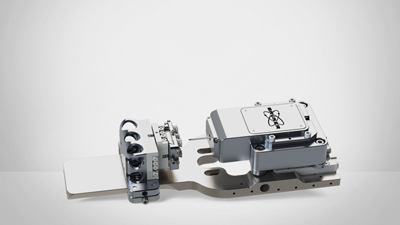Quasi-Static Nanoindentation
Quasi-Static Nanoindentation: An Overview
Quasi-static nanoindentation has become the standard technique used for nanomechanical characterization of materials. A quasi-static nanoindentation test is performed by applying and removing a load to a sample in a highly controlled manner with a geometrically well-defined probe.
During the nanoindentation process, a force is applied by the transducer and the probe displacement is continuously measured to produce a traditional force vs. displacement curve. The resulting force vs. displacement curve serves as the 'mechanical fingerprint' of the material, from which quantitative nanoscale material properties can be determined. Bruker's Hysitron nanoindenters measure the force and displacement of the nanoindentation probe with a unique three-plate capacitive transducer design. This transducer design provides an unsurpassed noise floor and ultra-low working force.
The tightly controlled construction and calibration standards used for the capacitive transducer in combination with the precisely machined, rigid nanoindentation probes produce quantifiable, reliable measurement on any material.
Analysis of the measured force vs. displacement curve (particularly the unloading segment) provides the user with quantitative information regarding the mechanical properties of the sample. Values typically obtained from quasi-static nanoindentation testing are Reduced Modulus (Er) and Hardness (H). However other information such as fracture toughness, stiffness, delamination force, and film thickness can also be obtained.
All Hysitron standalone nanoindentation systems are capable of in-situ SPM imaging. Using the same probe to scan a sample surface immediately before and/or after a test allows for precise placement of the test as well as observation of deformation events or sample recovery after the test.
Quasi-static nanoindentation from Bruker is designed for maximum versatility. Standard with all Hysitron standalone nanoindentation systems and equipped with a standard maximum force up to 10 mN and a noise floor of less than 30 nN, quasi-static nanoindentation covers a large range of sample testing possibilities.
How Quasi-Static Nanoindentation Works
Bruker's nanoindentation transducer is unique in its operation and is the only nanoindenter system in the world to use the three-plate capacitive design. Displacement is measured by running two AC signals that are 180° out of phase with each other to the top and bottom plate of the three-plate capacitive sensor. The AC signals are observed by the center (floating) plate and the sum of the signals corresponds to a measured displacement. To apply a load, a DC offset is applied to the lower plate of the transducer that electrostatically attracts the center plate downward. The resulting difference in the sums of the AC signals results in an offset in the sum of the AC signals and thus a change in displacement.
Quasi-Static Nanoindentation Data Analysis
Hysitron nanoindentation systems include a quasi-static data analysis package that uses a standard model to fit the initial unloading portion of the force vs. displacement curve to extract the Reduced Modulus (Er) and Hardness (H) values.
Quasi-static testing enables the nanoindentation probe area function to be calculated using an advanced analysis software package to ensure any variations in probe geometry are accounted for.
Mechanical Properties Measured Using Nanoindentation
Nanoindentation is a powerful technique used to quantitatively characterize the mechanical properties of small volumes of material. By fitting the appropriate models to the force vs. displacement curve obtained during the test, material properties such as elastic modulus, hardness, creep, stress relaxation, interfacial adhesion, and fracture toughness can be measured at the nanoscale and microscale.










